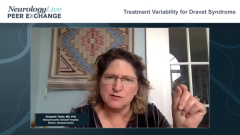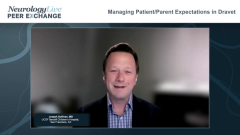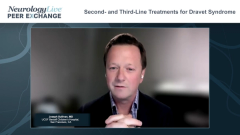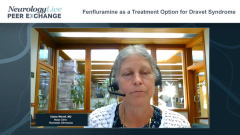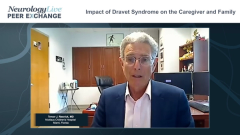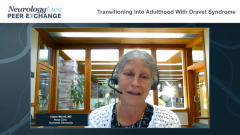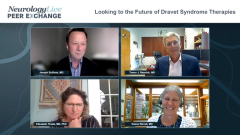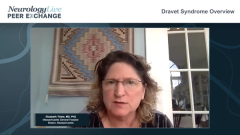
Therapies for Children and Adults with Dravet Syndrome
The panelists discuss the possibility of treating Dravet syndrome in older children and adults and the effects if the therapies were effective.
Episodes in this series

Joseph Sullivan, MD: Before we wrap up, let’s talk about 1 more thing. Are these types of therapies going to be appropriate for older children or even adults? We don’t have any data. The preclinical model is all in mice. But any thoughts about if it’s ever going to be too late to intervene for some of these patients? Trevor, if these treatments get approved, would you recommend it for your 25-year-old patient if they were shown to be safe and effective?
Trevor J. Resnick, MD: That’s a difficult question.
Joseph Sullivan, MD: I’m putting you on the spot.
Trevor J. Resnick, MD: It’s an issue that requires a conversation. Obviously, if you’re having that conversation with parents of a 1-year-old, it’s a very different conversation from 1 with parents of a 25-year-old. If there’s a treatment that’s effective, even if it can mitigate some of the progression, it’s worth doing. Every parent will want to know that, even if it’s late in the game. If it may make some positive difference, I want it for my child. Under those circumstances, I would absolutely recommend it.
Joseph Sullivan, MD: Elaine or Elizabeth, what are your thoughts?
Elaine Wirrell, MD: The other potential issue is that we know SUDEP [sudden unexpected death in epilepsy] doesn’t go away. SUDEP is a risk that continues through adulthood. If this really significantly reduces seizures and gets rid of that SUDEP risk or markedly reduces it, that’s very exciting as well. As Trevor says, it needs to be a conversation. But I certainly would not exclude adults from this treatment.
Elizabeth Thiele, MD, PhD: I completely agree. Sure, there’s great excitement that if we can identify Dravet early—after that first seizure with a gene panel, and treat early with a genetic therapy—could that be life transforming and changing? Hopefully it can be. But even if I had a 25-year-old or a 40-year-old who I knew had Dravet, if it was an effective therapy—and as Elaine said, would reduce or eliminate the SUDEP risk—I’d absolutely want it to be available for that patient as well.
Joseph Sullivan, MD: There’s this theme that it’s never too late, right? The brain always has the ability to learn, adapt, and develop. If you look at some of the clinical trials we’ve talked about, the mean age in a lot of these trials is 9 or 10 years. Hundreds if not thousands of seizures have passed in these poor children’s lives, yet we were able to see improvements in behavior and executive function by giving symptomatic seizure relief. Imagine if we can give symptomatic seizure relief plus get at the underlying etiology. We all agree that earlier is going to be better but that at the same time, it’s never too late.
To close, for all our neurologists watching, I wonder if we could go around and each give 1 tip or helpful piece of advice for them if they’re treating patients with Dravet syndrome. Elaine, I’ll start with you.
Elaine Wirrell, MD: One thing we hadn’t talked much about was having a really good rescue plan. We know that this group of patients is very susceptible to prolonged seizures and breakthrough seizures, so it’s important to have a clear rescue plan at home and medication. Typically, in young persons with Dravet syndrome who tend to have a high risk of going into status epilepticus, we say that if you see a convulsive seizure, don’t wait the 5 minutes. Just give the rescue medication. But you should also have a plan for what should happen if that rescue medication doesn’t work. It gets tougher because there’s a lot more individuality between what works for status epilepticus or prolonged seizures after the rescue medication has failed. It’s important to develop that as the neurologist who knows that patient best.
Joseph Sullivan, MD: Trevor?
Trevor J. Resnick, MD: These are just pragmatic suggestions. For a number of patients, the triggers are the major issue. Having a preventive plan for the triggers is also really important, especially for hypothermia. Be able to address it when they begin to see it. That gives parents some element of control over the risk for status epilepticus. Obviously, some kids have different triggers. It’s important to be able to talk with families about what triggers their child has and to help obviate that as much as possible. Each individual trigger and trial can be an episode of status epilepticus, and if you can stop just 1 or 2, you’ve made a difference. Having the parents involved in that process is so important.
Joseph Sullivan, MD: Absolutely. Elizabeth?
Elizabeth Thiele, MD, PhD: One would be to recognize it; especially child neurology. You’re right. Everyone knows Dravet syndrome. There’s been a lot of excitement, particularly for recent trials and FDA approval, but I still see kids who could have been diagnosed earlier. More available access of genetic testing, which should definitely become standard of care for epilepsies in childhood with these more specific treatments, is very important.
If I had to give 1 piece of advice in addition to what Elaine and Trevor said, it would be to recognize the impact on the family. That’s where epilepsy centers can be helpful, because epilepsy centers I know about have a better infrastructure for providing support for families and siblings and resources to refer people to than many child neurologists who are treating everything we’re able to. The impact on the siblings and parents is incredibly profound. I feel very passionate that we should not only treat seizures but also take care of patients and families.
Joseph Sullivan, MD: You took the words right out of my mouth. With a lot of my child neurology colleagues, epilepsy seizures is half of what they do. Sometimes there may be this reticence, like “I got this.” Many times you do. But as we’ve hopefully shown, there’s so much value in making a precise diagnosis, making it as early as possible, and using the available literature for some new therapies to help optimize the treatment. Equally important, we close with these clinical trials. The way these trials are going to be successful, and the way we’re going to get them in the hands and brains of the patients who need them, is for them to be aware of the trials and these comprehensive epilepsy centers where we all take care of more than a handful of these patients. That’s going to allow these patients and their families the best opportunity for improvement in their overall quality of life as we work toward a cure.
Thank you, all. This has been a lively discussion. I look forward to doing this in person soon. To our observers and attendees, thank you for watching this NeurologyLive® Peer Exchange. If you enjoyed the content, please subscribe to our e-newsletters to receive upcoming Peer Exchanges and other great content right in your in-box. Thank you.
Newsletter
Keep your finger on the pulse of neurology—subscribe to NeurologyLive for expert interviews, new data, and breakthrough treatment updates.


